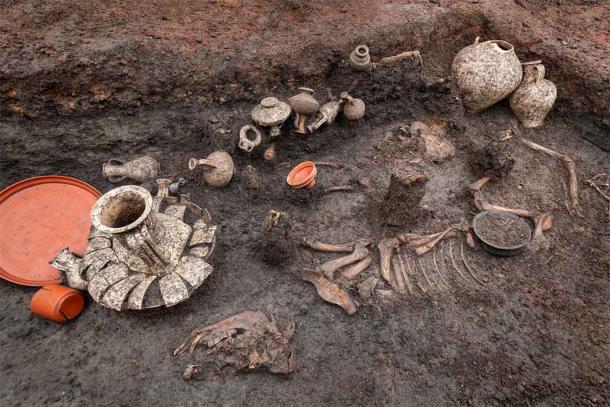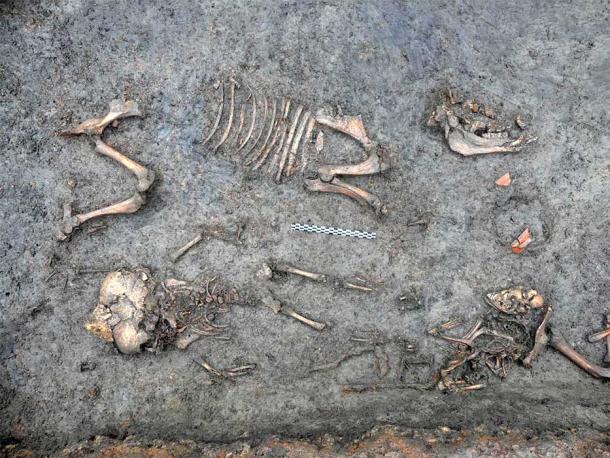Archeologists digging at France’s Clermont-Ferrand Airport have discovered the remains of a 2,000-year-old, upper-class, Roman baby and his pet dog. This rare Roman baby burial discovery further challenges traditional ideas that Romans unceremoniously disposed of their children.

Archaeologists were conducting excavations before airport construction works when they came across the Roman baby burial. (Denis Gliksman / INRAP)
Roman Baby Burial of Ancient Roman Rich Kid
Archaeologists from France’s National Institute of Preventive Archaeological Research (INRAP) announced on Thursday that they have discovered the grave of the small child during a dig at the Clermont-Ferrand Airport, in Aulnat (Puy-de-Dôme), in central France. According to a report in The Guardian , the burial included twenty containers, glass vases and the milk tooth of another child. This mysterious “ritual child burial” has been dated back to the Roman period, about 2,000 years ago.
What makes it unique is that the baby was buried with what appears to be its pet dog , with a bell collar. What’s more, the child’s coffin was found in a 6-by-3-foot grave (1.8 by 0.9 meters) with twenty objects that had been ritually placed around the child’s body. Among the grave goods were twenty terracotta vases and glass pots, two headless chickens, half a pig, three hams and other pork cuts also added to the burial. The conclusion: this was one seriously rich Roman kid.

Archaeologists excavating the Roman baby burial. (Denis Gliksman / INRAP)
Babies Were Buried Differently from Adults in Roman Times
A report in AW-Journal says this rare discovery of a Roman baby burial took place in December 2020 during preventive excavations conducted by INRAP at the behest of the State and the Drac Auvergne-Rhône-Alpes , upstream of new construction works planned at the Clermont-Ferrand Airport . The researchers think the child was only about one year old when it died. They also discovered the skeletal remains of “a pet dog” buried alongside the child.
The place, or role, of children within Roman social structure was complex and they were treated distinctly differently from adults, in life and in death. According to a paper on Taylor Francis Online , children in Roman literary sources received “special protections under the law until the age of seven.” In the archaeological record Roman children are most often found buried differently from adults. By analyzing these differences in burial rituals , researchers can reach certain conclusions about general cultural distinctions that influenced the Roman concept of childhood and the resulting Roman burial customs .

Archaeologists at work during the excavation of the Roman child burial. (Denis Gliksman / INRAP)
A Baby Buried with a BBQ Banquette
This particular Roman baby lived just decades after the alleged birth of Jesus during the reign of either Emperor Augustus (27 BC to 14 AD) or Tiberius (14 to 37 AD). In an article in the Daily Mail , a spokesperson from INRAP, Dr. Lautier, is reported to have explained that toddlers rarely benefit from the same funeral practices as their elders, who in the Roman period were generally cremated. Furthermore, the archaeologist said the graves of young Gallo-Roman children are often “located outside the community funeral home and sometimes even buried near the family home.”
The child’s grave is said to be “quite exceptional” both in its size and because of the quality of the ritually added grave goods that have been recovered. But perhaps the biggest indicator of the baby’s high social class was the profusion butchered meats and over twenty food vessels. In comparison, the institute said that in excavations of this type of tomb archaeologists generally find “one or two pots placed at the foot.” The child had clearly come from a family “that was very rich,” said Dr. Lautier.

The Roman baby burial included an infant skeleton, surrounded by a pet dog, a pig, twenty terracotta vases and various food and meat offerings. (Denis Gliksman / INRAP)
Traditional Infanticide Theories Are Getting Tired
In 1993, Dr. Martin Millett from the Faculty of Classics at the University of Cambridge, and Dr. Rebecca Gowland from the Department of Archaeology at Durham University, published the research paper titled Infant and child burial rites in Roman Britain: a study from East Yorkshire . The researchers wrote about the discovery of infant burials on excavated domestic sites in Roman Britain and said that, in the past, these burials have often been dismissed as “a product of unceremonious disposal.”
Traditionally, this phenomenon of the “unceremonious disposal” of Roman children was taken as evidence for mass infanticide in the Roman world . However, in this 1993 paper, new evidence was presented from two large groups of infant burials in East Yorkshire, in England, that demonstrated how Roman baby burials of neonatal infants followed “a careful age specific funerary rite.” The researchers concluded that child rituals were definitely performed, and this finding “further undermines the widespread assumption that infants were disposed of without ceremony and as a result of infanticide” by Roman adults.

Once the vases were removed during the excavation, the archaeologists had a better view of the infant skeleton surrounded by a pet dog and a pig. (Ivy Thomson / INRAP)
Was Decency in Child Burial Perhaps a Class Thing?
Let’s return to the discovery of the Roman baby burial of an infant with its pet dog and all those meats in France. Just like the child graves discovered in England, this discovery pays testament to the complexity of Roman society and suggests that Romans didn’t “unceremonious dispose” of dead children. On the contrary, children were “sometimes” buried with great pomp and ceremony.
However, it has to be added that the research presented by Millett and Gowland in 1993, and again now, pertaining to child burial rituals , is all from upper class Roman society. Perhaps ritual child burials, with the inclusion of meats and vessels, was an upper-class thing, while it was greatly different among families in lower classes, where there was little of value, including food, to be spared for inclusion in their child burials .
Top image: The Roman baby burial discovered during airport construction work at Clermont-Ferrand in France included the remains of a Roman infant, a pet dog and a large selection of valuable grave goods. Source: Denis Gliksman / INRAP
By Ashley Cowie
 RSS Feed
RSS Feed















 January 18th, 2021
January 18th, 2021  Awake Goy
Awake Goy  Posted in
Posted in  Tags:
Tags: 













